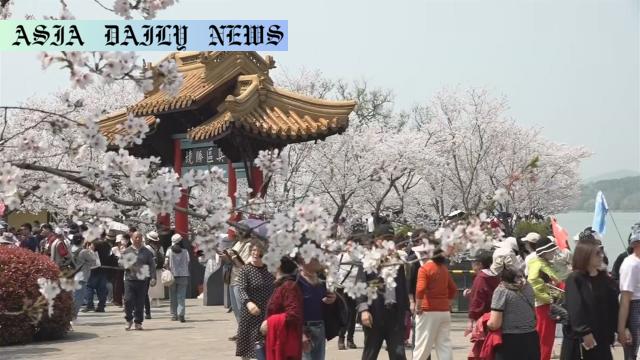Cherry Blossoms: Japanese and Chinese citizens gathered in Wuxi under cherry blossoms to nurture relations and celebrate culture.
- Cherry blossoms in Wuxi represent enduring Japan-China friendship.
- Event marks 37 years of tree planting inspired by Kiyomi Hasegawa.
- Attendees planted trees, performed arts, and celebrated ties.

Fostering Friendship Through Cherry Blossoms
In a recent heartwarming display of camaraderie, Japanese and Chinese citizens gathered at a park in Wuxi, located in Jiangsu Province of eastern China. Under the enchanting spectacle of nearly 30,000 blooming cherry trees, participants celebrated not only the beauty of nature but also the enduring friendship between their nations. This annual event draws inspiration from Hasegawa Kiyomi, a former member of the Imperial Japanese Army, who began planting these trees 37 years ago to foster goodwill and harmonious relationships between Japan and China. Today, Japanese volunteers have continued Kiyomi’s legacy, ensuring the park thrives as a symbol of mutual respect and collaboration.
A Legacy Rooted in Collaboration
Hasegawa Kiyomi’s initial hope was simple but profound: planting seeds of goodwill and nurturing long-lasting bonds between the two cultures. Over three decades later, his vision has flourished into a breathtaking spectacle of cherry trees and a symbol of enduring friendship. The park, now one of China’s largest cherry blossom sites, stands as a testament to the dedication of volunteers from both nations, embodying the ideals of unity and peace. Shibata Yutaka, Hasegawa’s son-in-law and head of the volunteer group overseeing the park, has vowed to uphold this legacy by encouraging future generations to cherish this cultural bridge.
Celebrating Cultural Unity
The recent friendship event held amid Wuxi’s blooming cherry trees featured an array of activities symbolizing cross-cultural unity. Japanese and Chinese musicians, dancers, and singers enchanted the audience with their artistic performances. Participants also partook in tree planting, covering the roots with soil and adorning the branches with plates inscribed with messages of friendship. Ambassador Kanasugi Kenji, who traveled from Beijing to attend, emphasized the significance of such efforts in nurturing relations between nations. Visitors, too, expressed their wish for the long-lasting improvement of bilateral ties, highlighting the role of events like these in fostering goodwill.
A Blossoming Example for the Future
As the cherry blossoms in Wuxi bloom in full brilliance, this celebration serves as a poignant reminder of what can be achieved through collaborative efforts and mutual respect. Each planted tree represents hope, unity, and the willingness to forge stronger connections despite historical differences. The event is not merely about admiring nature but also about understanding the importance of cultural and diplomatic ties in shaping a better future. It calls for continued dialogue and cooperation between the Japanese and Chinese communities, proving that even small acts of kindness and dedication can lead to lasting change.



Commentary
The Transformative Power of Cherry Blossoms
The cherry blossom, or sakura, has long been a cherished symbol of renewal, beauty, and the fleeting nature of life. Its significance transcends borders and cultural differences, making it an apt representation of the efforts in Wuxi to promote friendship between Japan and China. Watching Japanese and Chinese people come together under these blossoms is a heartening example of how nature can bridge divides and inspire warm connections.
Carrying the Legacy Forward
The story of Hasegawa Kiyomi is both touching and inspiring. In a world often marred by conflict and misunderstanding, his initiative to plant cherry trees in Wuxi shows the power of an individual act of goodwill. The fact that volunteers from both nations have carried his vision forward for over 37 years speaks volumes about the shared commitment to build lasting bonds across borders. This collaboration exemplifies how people can choose to focus on shared values rather than differences.
A Celebration of Cultural Unity
Beyond its symbolic value, the event was vibrant with cultural expressions from both nations. Performances of music, dance, and song provided a canvas for showcasing the rich heritage of Japan and China, fostering admiration and respect. Events like these not only strengthen ties but also encourage people to learn about and appreciate each other’s traditions, fostering empathy and understanding. The planting of trees, accompanied by friendship messages, is a genuine gesture of hope for greater solidarity in the future.
Lessons from Wuxi
The cherry blossom park in Wuxi teaches us an invaluable lesson about resilience and reconciliation. It reminds us that even after historical rifts, countries and cultures can come together through collective efforts. It challenges us all to engage in meaningful actions, however small, to contribute to better relationships within our communities. As the trees bloom season after season, so too does the aspiration for a future marked by peace and cooperation.